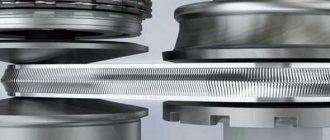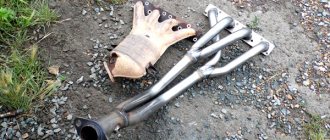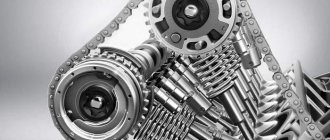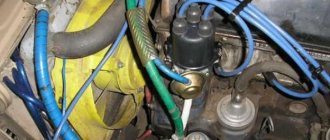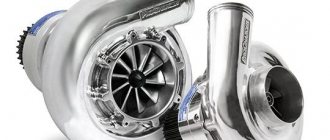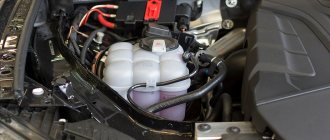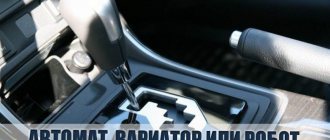A little theory
First, it’s worth understanding exactly how the power of the power unit is increased. First, a trivial description of how an internal combustion engine functions: it runs on an air-fuel mixture, which ignites and burns in the cylinders, providing the engine with the necessary energy to operate. The mixture consists of two components - air and fuel (diesel or gasoline).
For efficient combustion of the fuel-air mixture in the cylinders, a certain amount of fuel and a certain amount of air are required. And if there are no particular problems with supplying more fuel, then driving more air into the cylinder is no longer so easy.
To solve this problem, a turbine or compressor can be used, which we consider in this article. And although both of these devices force air into the engine, they work on completely different principles.
What happens in the end
As you have already understood from the above, installing any type of compressor is not the easiest task. Before installation, it is worth carefully weighing the pros and cons of each of the available supercharging solutions, as well as calculating the necessary final power indicators in accordance with the task at hand.
Today, the optimal system can be considered a dual supercharging system, when a mechanical compressor and turbocharging are used simultaneously on one engine. At the same time, the devices operate at different speeds, providing maximum elasticity and comfort over a wide range of engine speeds.
Source
Compressor
This is a mechanical type air injection device, it appeared before turbines, but is still used by both car manufacturers and tuning car repair shops. The compressor is mounted, one might say, “next to the motor” and does not directly interfere with its design.
There are three types of compressors: centrifugal, rotary and screw. The main difference between them is the way the air is compressed and how it is supplied to the engine intake.
The operating principle of a centrifugal, rotary and screw compressor
A centrifugal compressor is an impeller that rotates at high speed and forces air into the compressor housing. The rotation speed can reach 50-60 thousand revolutions per minute. In this case, the air that enters the central part of the impeller is shifted to its edge under the influence of centrifugal force. As a result, air leaves the impeller at high speed but at low pressure. Next, to increase air pressure, a diffuser is used, which consists of blades located around the impeller. These blades convert fast air flow with low pressure into slow air flow with high pressure. This type of compressor is the most common and most efficient.
A rotary compressor consists of two cam shafts that rotate and force air into the intake manifold. Rotary compressors are large in size and located directly above the engine.
A screw compressor consists of two rotors, similar to a set of worm gears. As a result of their movement, air ends up between the blades, so it is compressed and supplied to the engine intake. The screw rotor requires high precision during production, so it is quite expensive.
Whatever the design of the compressor, it is always mounted on a crankshaft belt drive, which means it uses the energy of the engine itself to compress air.
Compressor advantages:
- requires minimal maintenance;
- long service life, most often enough for the entire period of using the car;
- no interference with the engine structure;
- does not require engine oil for lubrication;
- works efficiently at low speeds;
Compressor disadvantages:
- power is noticeably lower than that of a turbine;
Turbine
Unlike a compressor, a turbine is “built” into the engine, uses its oil and operates from exhaust gases, that is, it “interferes” with the exhaust system.
The principle of operation of the turbine is as follows: gases enter the engine exhaust, then go to the hot turbine wheel (spinning it), the rotational energy is transferred to the cold wheel, which begins to rotate quickly and pump air into the engine intake.
Turbine advantages:
- higher operating efficiency;
- uses the energy of exhaust gases;
Disadvantages of the turbine:
- works efficiently at high speeds;
- there is so-called turbo lag or a delay between pressing the gas pedal and increasing engine power;
- uses engine oil for lubrication, and therefore the engine requires more frequent replacement;
- increased oil consumption;
- short service life, in the best case - up to 200 thousand kilometers;
- high cost of repairs;
- installation difficulties;
In fact, the main and only advantage of the turbine is the impressive increase in engine power; then there are only disadvantages.
What is better, a turbine or a compressor?
In fact, it all depends on what kind of effect the car owner needs, and this is always strictly individual. The following conclusions can be drawn.
Turbine. Gives a huge increase in engine power, up to 40%. Relevant for rally races or for fans of street racing. True, you will have to spend a lot of money both on the purchase of the device itself and on its installation, configuration and maintenance. Plus you have to put up with high oil consumption, lag and frequent repairs.
Compressor . Suitable for drivers who do not need such an impressive increase in engine power. At the same time, the car owner does not want to have problems with servicing the equipment, since the compressor is used according to the “install, configure and forget” principle - its service life is enough for the entire period of using the car. And the cost of the device itself is several times lower.
Source
The main differences between a turbocharged engine and a compressor
Many automakers are gradually abandoning conventional naturally aspirated engines and switching to turbocharged or compressor engines. But what is the difference between them, and which one is better?
Why are superchargers needed?
Compressors or turbines are installed on engines to increase their power. With the help of these units you can achieve good power and dynamic performance with a minimum engine displacement.
The increase in power occurs due to the injection of a large volume of air into the cylinders. Almost all modern engines follow the path of installing a turbine, but compressor superchargers, on the contrary, are becoming a thing of the past.
Compressor motors
Mechanical compressor superchargers began to be installed on cars a long time ago, back in the 60s of the last century. The compressors are chain driven from the crankshaft and start working as soon as the engine starts.
Scope of application and operating features
What is better, a turbine or a compressor? For a complete answer, let's look at both devices in parts.
Structurally, a turbine is an engine that is constantly in motion by converting the energy of liquid or steam into mechanical energy. It must be said right away that the drive mechanisms for both are completely different.
The compressor is powered by the engine crankshaft and has an autonomous unit, while the turbine receives gases from the exhaust manifold and has no autonomy.
The difference in price is noticeable:
for a good quality turbine, pay about 550 bucks, and a compressor only 200, and the power percentage is the same, from 15 to 25% maximum. Additionally, there will be costs associated with installing and setting up the unit in a car service center.
Comparison of a mechanical compressor and a turbine
We are accustomed to the fact that any internal combustion engine is subject to a simple principle: the larger the dimensions of the engine, the higher its power. In principle, this is predetermined by the laws of physics, but engineering does not stand still in search of alternative ways to increase the thrust of power units without compromising their size.
One of them is the installation of an additional unit in the engine - a supercharger. Such a compressor allows a much larger volume of air to be delivered to the cylinders than with the standard design. This means that it is possible to increase the supply of fuel while maintaining a constant volume of the combustion chamber.
Somewhat later, another device was developed - a turbine, which performs basically the same task, but in a slightly different way. Today we will talk about the differences between a turbine and a compressor.
RPM difference
One important difference from the others is that the compressor can operate at low and minimum speeds, but the turbine cannot operate at all. As a rule, it requires speeds of 3500 rpm. to create pressure. But the compressor is not able to use fuel economically. During acceleration, the efficiency of the compressor will not be visible for as long as we would like. The turbine starts working a little later, as a “hole” is noticed at the start, but after a slight acceleration everything disappears.
The compressor is designed to constantly supply the mixture for ignition
, but affects the loss of power, which cannot be said about the “sister”. To maintain the operation of the turbine, you need to appear at a car service center once or twice for diagnostics, otherwise you will end up with a non-working system.
The turbine requires the installation of an additional cooler - an intercooler (see article - “What is an intercooler”), since the air flow has a high temperature.
Installing an additional radiator
also brings difficulties in terms of finding a place for installation. The efficiency of the compressor is slightly less than that of the turbine.
Now the vast majority of owners are moving from gluttonous and bulky cars to miniature and economical ones (see List of economical small cars). In view of the fact that the cost of fuel is only growing exponentially, power units with a turbine unit will be popular among the majority of the population.
In this way, many will strive to save on car maintenance. The question of which is better, a turbine or a compressor, has been answered and does not require further discussion. Everyone must draw their own conclusions about the type of installation in accordance with their financial capabilities.
Ways to increase engine power
Before we look at the difference between a supercharger and a turbo and see which technology is better, it makes sense to familiarize yourself with the principles used to make modern powertrains more powerful.
The operation scheme of any internal combustion engine is quite simple: the driving force is the fuel, or rather, a mixture of air and fuel, which burns in the cylinders, forcing them to perform reciprocating motion. Both components are supplied to the engine separately. Fuel (for specifics, let's take gasoline) is supplied to the intake manifold through a fuel line, and its supply is provided by a separate pump. The air enters the engine by gravity, being cleaned through an air filter. If it becomes clogged, the power of the power unit drops, increasing consumption.
But if you use devices that provide an unhindered supply of increased volumes of air, and even under pressure, you can partially solve the problem of increasing engine power without the need to increase the volume of the combustion chamber. The amount of oxygen increases, which means that with simple adjustments you can achieve an increase in the supply of gasoline, as a result of which the engine efficiency increases.
The compressor and turbine precisely perform the task of pumping air into the cylinders, and to this day remain the most affordable and easily implemented devices for increasing the throttle response of an internal combustion engine with the same dimensions. Of course, there is still an increase in size - at least due to the presence of the additional devices themselves, but in proportional terms this is not comparable with the need to increase the volume of the working cylinders, since this will lead to the need to change the dimensions of the engine itself, including its housing as the most massive component of the entire car .
Well, now let’s look at the operating features of both types of devices.
How power increases
Before finding out whether a compressor or a turbine is better, let's go over the principle of increasing power.
As you and I know, an internal combustion engine runs on an air-fuel mixture, it is this mixture that ignites in the cylinders and then burns - it consists of air and gasoline, which enter the intake manifold or engine in various ways:
- If you take gasoline, it is supplied through special channels (fuel pipeline), and a special pump handles its supply.
- If you take air, then it is not pumped in any way, but is simply sucked in by the engine through the air filter, and if the filter becomes dirty, then the power may even drop and consumption will increase.
What our devices do is they simply begin to frantically pump air into the cylinders, which has a positive effect on power. There is a lot of air, the fuel is “adjusted”, there is also a lot of it - the power increases. I think this is understandable. For those who do not quite understand, read the article - how a turbine works .
That is, both the compressor and the turbine pump only air into the cylinders and nothing else. I heard somewhere that fuel is also injected, but essentially this is nonsense. Then what is the difference, because both nodes do the same thing, why are they distinguished - which is better in the end?
In order to answer all these questions, it is worth remembering each of the components, the compressor appeared first
Turbine operating principle
Most vehicles are equipped with four-stroke engines, the operation of which is controlled by an intake/exhaust valve system. Each operating cycle of a modern power unit, as the name suggests, includes four strokes, or episodes, as a result of which the engine crankshaft makes two full revolutions.
Let's look at these steps in more detail:
- during intake, the pistons move downwards, while at the same time fuel assemblies enter the combustion chamber (for diesel engines, only air enters the combustion chamber);
- The compression stroke involves compressing the air-fuel mixture;
- during the expansion stroke, the compressed mixture is ignited by a spark generated at a certain moment by the spark plug (in diesel units, ignition occurs spontaneously as a result of pumping diesel fuel under higher pressure). As a result of combustion, an explosive expansion of the mixture occurs, which is converted into heat and exhaust gases;
- The exhaust stroke is characterized by the release of the exhaust with the simultaneous upward movement of the piston under the influence of exhaust gas pressure.
Without going into details, we note that this scheme of motor operation suggests the possibility of increasing its efficiency in the following ways:
- increasing the volume of the combustion chamber and the entire engine;
- increase in crankshaft speed;
- installation of turbocharging.
The first method can be implemented in two independent directions: by increasing the size of the cylinders or by adding new cylinders. Both methods are applicable, but solely due to the increase in the mass and dimensions of the power unit. That is, this is a clearly expressed extensive type of development.
An increase in the number of crankshaft revolutions is possible by increasing the number of strokes of the piston, but this method also has severe limitations in applicability, caused both by technical features of the implementation, as well as by a drop in the overall efficiency of the engine due to the inevitable increase in losses, especially on the intake stroke.
The classic scheme of operation of an internal combustion engine involves the use of air entering the engine by gravity. The use of turbocharging allows the same volume of air to be supplied to the cylinders, but in compressed form, that is, actually increasing the amount of oxygen in the combustion chamber. This means that more fuel can be supplied per unit time, which makes it possible to increase the efficiency of the power unit.
Structurally, this scheme is implemented as follows: exhaust gases resulting from the combustion of fuel assemblies are directed to the rotor blades, rotating the turbine shaft. This drives the shaft of the compressor unit, which is actually responsible for supplying atmospheric air under pressure to the cylinders. Along the way, the air, heated due to the compression effect, is cooled by the intercooler, which prevents earlier ignition of the combustible mixture due to an increase in its temperature.
Operating principle of the compressor
When using methods to increase the power of a power unit by pumping a larger volume of air into the cylinders, the first to use were not turbochargers, but mechanical analogues, or simply superchargers.
These units, unlike a turbine, use a crankshaft as a driving force, the rotation of which is transmitted to the compressor shaft using a belt/chain drive, that is, purely mechanically.
The principle of operation of the supercharger is based on increasing the amount of air supplied to the combustion chamber, which makes it possible to compact the air-fuel mixture. The higher the density, the more powerful the fuel assembly will ignite, transferring more energy to the crankshaft and increasing the efficiency of the power unit.
You need to understand that there is an optimal proportion of combustion of a mixture of fuel and air. For gasoline, it is 14:1, that is, one volume of air should account for one part of fuel. Thus, a simple increase in the volume of air will not only lead to an increase in the power of the explosion of the mixture, but will even worsen its parameters. This means that the supply of gasoline also needs to be adjusted, which is done in cars whose engines are equipped with a mechanical compressor. Moreover, such adjustments are made automatically, taking into account the operation of the supercharger.
The increase in power when using this method is about 45%, and the amount of torque increases on average by 30%. These are very good indicators, considering that in this case there is no need for intervention in the timing belt.
Such a mechanical supercharger begins to work immediately after starting the engine, as soon as rotational torque from the crankshaft is applied to its shaft from the drive belt, put on the crankshaft drive gear and connected to the compressor gear. The supercharger rotor begins to suck in air, compresses it and directs it under pressure into the intake manifold. Operating compressor rotation speeds are 50,000-60,000 rpm. This is enough to increase the amount of air supplied to the cylinders by 50%.
But there is one problem: when air is compressed, its temperature rises in proportion to its density, and this leads to the fact that when the mixture is ignited by a spark plug, it will not be able to give off all its energy. So, along with increasing the amount of fuel, in order to maintain the “golden” ratio, it is necessary to solve another problem: cooling the mixture. For this purpose, the mechanical compressor includes an intercooler.
The cooling mechanism can be implemented in several ways: using coolant or through cold air flowing into the car.
So, schematically, the difference between a compressor and a turbine is minimal, but structurally it is very significant.
turbine VS compressor... Which side are you on?!
While working with one interesting machine, I asked myself the question: “What distinguishes a compressor from a turbine, or vice versa?! As you know, rearranging the terms does not change the sum...”
Having sailed a little through the expanses of the Internet ocean, I came to the following...:
Turbine
– a rotary engine, the peculiarity of which is continuous operation. The rotor converts the kinetic energy of steam, gas or water into mechanical energy. Today, turbines are actively used as the main element of the drive of a wide variety of vehicles (land, sea and air). No matter how incredible it may seem, an attempt to create a mechanism similar to a modern turbine was made before our era. And only at the end of the 19th century, with the development of thermodynamics and mechanical engineering, steam turbines began to appear, characterized primarily by high functionality.
A compressor
, in turn, can be different and used in a wide variety of industries. It is necessary for compressing and supplying gases (including air) under pressure. This device was invented in order to significantly increase the maximum engine power, because more air is pumped into the combustion chamber. As a result, more fuel enters the cylinder, which in turn means that the final goal has been achieved. For clarity, here are some numbers: on average, a compressor can add about 46 percent of power (plus 31 percent of torque). Now these devices are actively used to increase engine power in both cars and trucks. Today, compressors are the most optimal and economical option for those who want to increase engine power and add a certain amount of horsepower to it.
Comparison of turbine and compressor
And so, to summarize, the difference between a compressor and a turbine is as follows:
= The compressor ensures proper operation of the engine (uninterrupted combustion of impurities). = The turbine has no effect on horsepower loss (total power output of the power unit). = The degree of complexity of installing and configuring the device. In this regard, the compressor has an advantage. = The turbine requires an oil supply, which affects the entire operation of the car. = The turbine will have to be constantly maintained and diagnosed. = The turbine is installed directly into the engine, and the compressor is a separate device. = The compressor has a fixed power, and the operation of the turbine depends on the speed of the car. = A turbine is capable of accelerating a car at a higher speed than a compressor. = The compressor consumes more fuel with lower efficiency than the turbine. = The compressor can be selected for any car model, but the turbine has a small selection. = The cost of the turbine itself and its installation is higher than the price of the compressor.
Which is better: compressor or turbine?
To evaluate the advantages and disadvantages of both approaches, let's consider their features and differences:
- The main advantage of mechanical compressors is considered to be their ability to deliver a perfectly precise amount of air, which, in turn, allows you to obtain a balanced mixture. This reliability of the supercharger has the most positive effect on the operation of the entire power unit, eliminating the possibility of a number of malfunctions leading to a decrease in the overall engine life;
- The advantage of the turbine is due to the lack of a mechanical drive, since it is powered by the kinetic energy of the exhaust. Thus, power losses are minimized here, in contrast to the compressor, which spends up to 30% of the motor energy for its operation. But this is achieved by significantly reworking the gas distribution mechanism and a number of adjacent components. In addition, the greatest effect of the turbine is manifested when the power unit operates at maximum speed;
- From the above, one of the main disadvantages of the turbine follows: installing it on the engine is a very complex, responsible and time-consuming procedure. The process of setting up a turbocharger is no less complex. When installing it, it is necessary not only to install additional equipment, but also to modify the power unit itself, and in some cases, the transmission, since the load on the box increases significantly;
- when using a mechanical compressor, the number of engine modifications is several times less, and most of them are superficial;
- Installing a supercharger in the engine compartment is generally easier than its turbocharged counterpart. The same can be said about setting up a mechanical compressor, which consists in selecting the optimal parameters of the air-fuel mixture. Installation of the supercharger is greatly simplified when using ready-made kits specially designed for such a procedure;
- installation/tuning of a turbine requires the contractor to have a thorough knowledge of the theoretical part and numerous practical nuances. Therefore, the vast majority of motorists are unlikely to be able to do this procedure on their own, and not every car service center will undertake such work. Installation of mechanical supercharging in this regard is almost an order of magnitude simpler;
- Another feature of the turbine is its high sensitivity to the quality of fuel and engine oil. Here, the problem of supplying lubricating fluid and draining it into the sump is solved autonomously, which complicates the design and increases operating costs (it is necessary to change the oil in the turbine more often than in the engine). Ignoring this rule will inevitably lead to turbocharger malfunctions and a number of additional problems. The compressor in this context is much more tolerant of the quality of fuel and lubricants;
- Turbocharging is a complex technology, so a turbocharger requires special care. There is a considerable list of routine operations included in the maintenance work of the turbine and intercooler. For its mechanical counterpart, the main problem is concern for the cleanliness of the incoming air flow, and even then when using superchargers with screw and cam mechanisms;
- the turbine does not perform very well at low engine speeds, sometimes demonstrating an effect called “turbo lag”. And only when you reach medium crankshaft speeds can you feel an increase in power, which becomes very noticeable at maximum speeds. If the vehicle is driven primarily in city driving, the turbocharged engine may not be efficient. Note that the latest generation turbines are partially free of this drawback, confidently coping with engine operation at low speeds. But the cost of such devices is high. The operation of the compressor, as already noted, is practically independent of the crankshaft speed, forming an effective boost throughout the entire power range. The power gain here will be approximately the same regardless of the speed of the power unit;
- The supercharger is a fairly autonomous unit that is connected to the motor with a small number of interface parts, which simplifies its maintenance/repair. A turbocharged compressor is much more closely integrated into the engine, and its maintenance requires experience and knowledge that is not typical for performing such work on a conventional atmospheric power unit;
- The undoubted advantage of the turbine is that it provides a higher increase in power. But turbine heating becomes a problem that is not so easy to solve. As a result, wear and tear on the turbocharger itself increases sharply, and engine parts deteriorate faster, reducing its overall service life. So we have to improve the cooling system, which further complicates the design;
- The compressor begins to work effectively as soon as the crankshaft begins to rotate. That is, even at idle it will form a larger volume of fuel assembly than that of a classic aspirated engine. But the same cannot be said about a turbocharger - at low speeds it will not function at all. However, the supercharger takes away a significant part of the power from the power unit (according to some estimates - up to 25-30%), therefore the increase in power compared to a turbocharger is less by about the same amount;
- Another disadvantage of a mechanical supercharger is its higher fuel consumption when compared with that of a turbine. Accordingly, the efficiency of the compressor is obviously lower. If we judge the usefulness of supercharging from the point of view of fuel economy, then the turbine is beyond competition;
- a mechanical compressor drive (chain or belt) is another headache for car owners, but compared to turbine maintenance this can be called a trifle;
- If we talk about self-installation of supercharging, then the compressor option has a lot of advantages. There are many models on the market with different characteristics, as well as ready-made kits. The choice of turbines is much narrower, and the situation will not change in the medium term;
- although the cost of a good turbocharger is much higher than that of a mechanical supercharger, and despite a number of its disadvantages, most cars are equipped with a turbine. The reason here is obvious - maximum increase in engine power.
